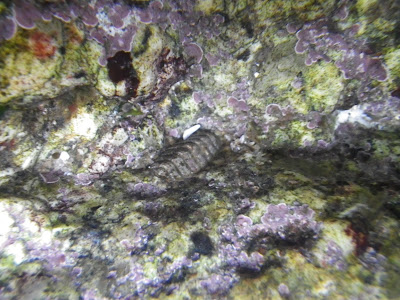The bay experiences a dynamic regime, alternating between periods of erosion and deposition. The underlying substrate is boulders and bedrock, however, variable amounts of sand may be deposited on top, sourced from the sand bar situated offshore. The communities encountered reflect the alternation between these regimes.
The shore alternates between periods of deposition (sandy) and erosion (stony).
April 2015
September 2013 January 2014
The overlaying sand has been eroded to reveal the boulders beneath. |
At the time of visitation the cove was comprised of boulders and bedrock with an occasional thin veneer of sand.
Habitat classification:
Substrate
|
LR (Littoral rock)
| ||||||||
Habitat
| LR.HLR (High energy littoral rock) |
LR.MLR (Moderate energy littoral rock)
|
LR.FLR (Features of ilttoral rock)
| ||||||
Biotope complex
|
LR.
HLR.MusB (Mussels and/or barnacles on high energy littoral rock) |
LR.MLR.BF (Barnacles and fucoids on moderately exposed shores)
|
LR.FLR.Lic.(Lichens on supralittoral and littoral fringe rock).
|
LR.FLR.Rkp (Rockpools)
|
LR.FLR.Eph (Ephemeral green or red seaweed communities
|
LR.FLR.CvoV (Littoral caves and overhangs).
| |||
Biotope
| LR.MLR.BF.Fser (Fucus serratus on moderately exposed eulittoral rock) | LR.MLR.BF.Rho (Rhodothamniella floridula on sand scoured lower eulittoral rock) |
LR.FLR.Lic.Ver (Verrucaria Maura on littoral fringe rock)
|
LR.FLR.Rkp.Cor (Coralline crust-dominated shallow eulittoral rockpools)
|
LR.FLR.Rckp.SwSed (Seaweeds in sediment- floored eulittoral rockpools).
|
LR.FLR.Eph (Ephermeral green or red seaweeds (Fresh water or sand influenced)
|
LR.FLR.Eph.EntPor (Porphyra purpurea and Entomorpha spp. on sand scoured mid to lower eulittoral rock)
| ||
Sub Biotope
| LR.MLR.BF.Fser.R (Fucus serratus and red seaweeds on moderately exposed lower eulittoral rock) |
LR.FLR.Rkp.Cor.Cor (Corallina officinalis and coralline crusts in shallow eulittoral rockpools)
| |||||||
 |
| One year ago these boulders were covered by sand. Now uncovered they are slowly being colonized by organisms, either from neighbouring rock or from planktonic recruitment. |
 |
| The ephermeral green and/or red seaweed biotope extends over much of the upper and mid shore coinciding with the rivers flow. |
 |
| Ephemeral green algae (Ulva spp - previously Entomorpha spp) |
 |
Unlike the upper shore the mid shore habitats appear unchanged from October, 2014 when this photograph was taken.
|
 |
| Beadlet anemone (Actinia equina) |
 |
| A Chiton, so highly camouflaged it could be missed among the coralline edged rock. |
 |
| Gibbula umbilicus can be found between and under the boulders, where conditions are damper. |
 |
| Limpets are able to withstand greater desiccation than other shore gastropods and are found all over the boulders, usually aggregated on the lee ward side. |
 |
| New fucoid growth, on a particularly sandy boulder. As the lower shore is reached the influence of subtidal sand scour increases and this influences the organisms found. |
 |
| Fucus sp and a red seaweed. |





No comments:
Post a Comment